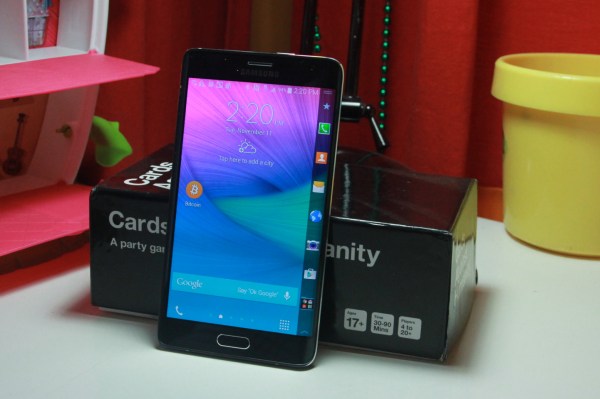Samsung either plays it entirely safe – see most of the Galaxy Tab line – or entirely gonzo. Whether it’s the chimerical Galaxy K Zoom or their curved TV, it’s as if the company has one floor dedicated to making vanilla ice cream an another dedicated to making unicorn-tear-flavored gelato. And it’s on that latter floor that the Galaxy Note Edge was born.
First thing’s first: this is essentially a Galaxy Note 4, one of the best mini-tablets available. While I remain an iOS user, I’ve turned to the Galaxy Note again and again over the past few weeks because of the bright screen and size. It is, to be clear, a definite iPhone 6 Plus competitor and, in some respects, beats that behemoth at screen clarity and usability.
As I wrote before, the Galaxy Note Edge is a beautiful phone slightly marred by an overzealous dedication to odd apps and doodads. In fact, nearly everything I wrote about the Note 4 is applicable here. To wit:
The screen, however, is a thing of beauty. It is a 5.6” Quad HD+ Super AMOLED with 2560×1440 pixel resolution with an extra 160 pixel wide bar down the side. This bar is actually part of the main screen but curved over the edge. This bar, which is touch sensitive, acts as sort of an interactive book spine. You can swipe across it to bring up different features – a list of frequently used apps, a news ticker, even a game that lets you fulfill burger orders – and you swipe up from the bottom to control settings. You can also swipe functions like current call activity or music playback to the bar and tap around through other applications. Samsung includes a number of preloaded bars including the aforementioned tickers and allows you to download apps like RAM management and games. The bars are essentially programmed just like Android widgets.
That, in a nutshell, is the primary difference between the Note 4 and the Note Edge – the Edge. This extra space is visible from the side of the phone and so can be used as a nighttime bedside clock that displays the time and weather as well as a mini voice recorder and even a ruler which, contrary to expectations, was quite usable. It also acts as sort of a window top bar in some apps as well. Is this enough of a feature to abandon, say, a brand new Note 4? Absolutely not. The edge is a nice-to-have, not a need-to-have. But taken to its logical conclusion we could assume that Samsung could put edges on both sides of the unit and do away with the bezel completely. The Note Edge isn’t about changing functionality as much as it’s about changing perception. When the screen is bendable, new tools can appear and Samsung is clearly interested in showing it is riding the cutting edge.
Again, you’re not going to go out of your way to pick up the Galaxy Note Edge but you will be intrigued. Like the other aforementioned unicorn-tear-flavored gelato you’re going to want to check things out and see if you actually like the edge screen or think it’s just a gimmick. As far as gimmicks go, however, I’m fine with this one and consider it a step forward. It’s a beautiful phone, well built, and usable enough to rival any other phablet. It’s not going to win any hearts and minds over less exotic devices (it’s $400 with contract on AT&T and about $840 unlocked, which could turn some off) but it does have a definite edge and it’s the shape of things to come.
[gallery ids="1081479,1081478,1081476,1081475,1081474,1081473,1081472,1081471,1081470"]
